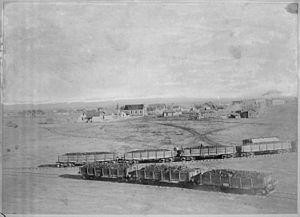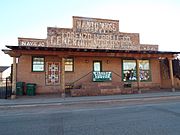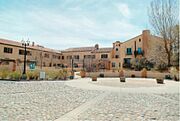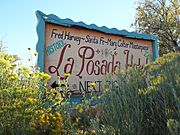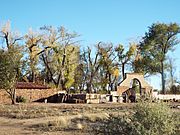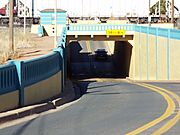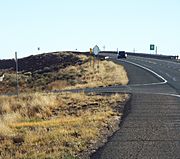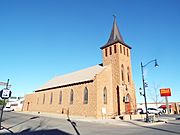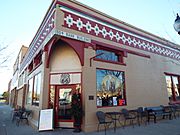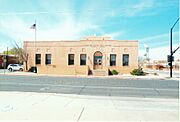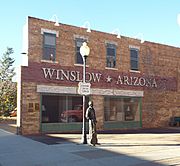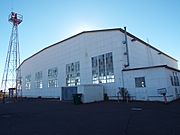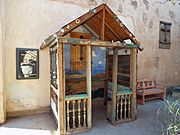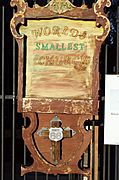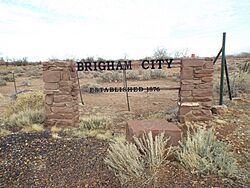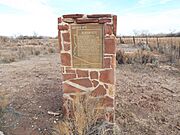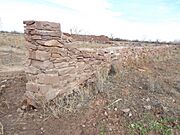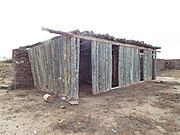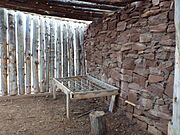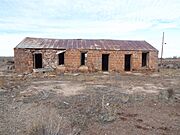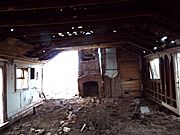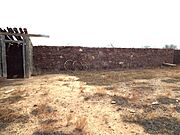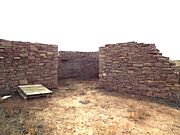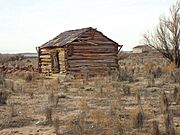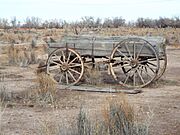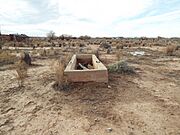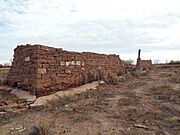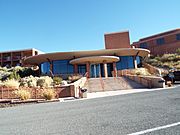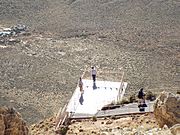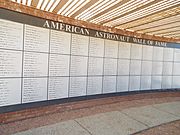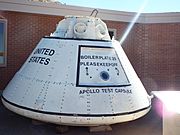List of historic properties in Winslow, Arizona facts for kids
Quick facts for kids
List of historic properties
in Winslow, Arizona |
|
|---|---|

Standing on the Corner sign
|
|
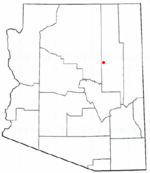
Map of Winslow in the Navajo County of the state of Arizona
|
Welcome to Winslow, Arizona! This article will take you on a journey through some of the town's oldest and most interesting places. You'll discover historic buildings, cool monuments, and even a famous crater. Many of these spots are so important they're listed on the National Register of Historic Places. Get ready to explore Winslow's amazing past!
Contents
Winslow's Story: A Quick Look Back
Winslow started as a busy railroad town in 1882. It was named after General Edward F. Winslow, a president of a railway company. Trains were super important back then!
Later, in 1926, the famous Route 66 was built. This road, also called "The Mother Road," went right through Winslow. It brought many travelers to the town. But by 1957, fewer people traveled by train. Then, when Interstate 40 was built, fewer cars used Route 66.
Winslow has many special places. Two areas, four buildings, and one ancient site are listed on the National Register of Historic Places. This means they are very important to history!
Brigham City: A Ghost Town in Winslow
Imagine a town that was once full of life, but now it's empty. That's a ghost town! Brigham City is one such place, located inside Winslow near the Little Colorado River. It was started in 1876 by a group called the Latter-Day Saints.
But flash floods kept washing away their dams and irrigation systems. This meant their crops couldn't grow. So, by 1881, everyone had to leave. Brigham City was added to the National Register of Historic Places in 1978.
Protecting Winslow's Past: Historic Preservation
Winslow has a special group called the Historic Preservation Commission. Their job is to find and protect the town's old buildings. They also help decide which places should be added to the National Register of Historic Places.
It's important to know that even if a building is on this list, its owner can still decide to tear it down. That's why people like Jim McPherson, from the Arizona Preservation Foundation, say it's super important to save these parts of our history before they are gone forever!
Standing on the Corner in Winslow, Arizona
Have you ever heard the song "Take It Easy" by the Eagles? It was a huge hit in 1972! The song has a famous line: "Standing on the Corner in Winslow, Arizona."
Because of this song, that corner has become a popular spot for tourists! You can find the corner and a cool statue at the intersection of Second and Kinsley Streets. It's a fun place to visit and take a picture!
Winslow's Historic Areas
Winslow has two special areas known as Historic Districts. These are neighborhoods where many old buildings are protected together.
- The Winslow Commercial Historic District was added to the National Register of Historic Places on April 20, 1989. This area includes streets like 3rd, Williamson Avenue, 1st, and Warren Avenue.
- The Winslow Residential Historic District was listed on April 28, 1989. This district covers Kinsley Avenue from Oak to Aspinwall.
Winslow's Historic Buildings
Here are some of the amazing historic buildings in Winslow. Some are on the National Register of Historic Places, and others are considered historic by the Winslow Historical Commission.
- The Lorenzo Hubbell Trading Post and Warehouse was built in 1900. It's located at 523 West Second Street. John Lorenzo Hubbell built trading posts in Arizona and New Mexico. He helped connect white settlers and the Navajo people. This building was added to the National Register of Historic Places in 2002.
- The La Posada Hotel was built in 1929 at 200 East Second Street. This hotel is the last of the famous Harvey Hotels. Inside, one of its restaurants claims to have invented the chimichanga! The hotel also used to be offices for the Santa Fe Railroad. It was listed on the National Register of Historic Places in 1992.
- The Winslow Underpass was built in 1925. It's on Route 87. This underpass was added to the National Register of Historic Places in 1988.
- The Winslow Bridge was also built in 1925, near the underpass on Route 87. It was listed on the National Register of Historic Places in 1989.
- Arcadia Hall is a large building, about 5,000 square feet, built in 1920. It's at 104 East First Street. This is the last historic building left on First Street! Arcadia Hall was once a popular place for music and dancing in Northern Arizona. In the 1920s and 30s, it was known as the most elegant ballroom between the Pacific Coast and Albuquerque. It had fancy chandeliers and a pit for orchestras playing Big Band music. Many high school proms and special events were held here.
As music changed, so did Arcadia Hall. It became the Desert Scene Elks Club. On August 20, 1966, a famous group called the Jackson 5 performed here! Michael, Marlon, Jackie, Tito, and Jermaine were between 7 and 14 years old then. Tickets cost about $1.25. The Jackson 5 soon became international superstars! The Desert Scene Elks Club also hosted the first performance by Arizona Blues Hall of Fame winner Tommy Dukes.
- The St. Joseph Parish church was built in 1900. You can find it at 220 West Second Street.
- The Navajo County Bank Building was built in 1904. It's at the corner of Second and Kinsley Streets.
- The U.S. Post Office was built in 1935. It's located at 219 Williamson Avenue and is part of the Winslow Commercial Historic District.
- The Winslow–Lindbergh Regional Airport Hangar was built in 1929 at 701 Airport Road. The airport was first called Barringan Airport. Both the airport and its hangar were built by Transcontinental Air Transport (TAT). The airport is named after Charles Lindbergh, a famous pilot who flew the first TAT flight into Winslow that same year. The airport also honors Melvin L. Kislingbury, a Winslow resident who died in a World War II flight mission in 1943.
- The "Tiny Church of the Mother Road" was built in 2012. It's at 116 East Second Street. This church is officially known as the smallest church on Route 66. There's even a sign outside that says it's the smallest church in the world!
Historic structures pictured
- Historic buildings and structures in Winslow
(NRHP = National Register of Historic Places)
(WHC = Winslow Historical Commission)
Images for kids
Here are some pictures of the remaining parts of Brigham City, the ghost town now inside Winslow. These photos were taken in 2019. Brigham City was added to the National Register of Historic Places in 1978.
Ancient Discoveries: Archaeological Sites
- The Nuvakwewtaqa Ruins are the remains of an old village built by the Sinagua people. They lived in this area between about 1050 and 1425 AD. This site was an important trading center. It also played a big role in how the ancient Hopi people moved east. The ruins were listed on the National Register of Historic Places in 1977.
Meteor Crater: A Giant Impact Site
Imagine a huge rock from space hitting Earth! That's how the amazing Meteor Crater was formed about 50,000 years ago. This giant hole is nearly one mile across, about 2.4 miles around, and more than 550 feet deep.
The crater is also known as the Daniel Moreau Barringer Crater. In 1909, Daniel Barringer said that the crater was made by a meteorite. In 1967, it was named a National Natural Landmark. This means it's a very special natural place. You can find the crater off Interstate 40 in Winslow, Arizona.
At the Meteor Crater Visitor Center, you can see the Holsinger Meteorite. This is the largest piece of the meteorite that created the crater! You can also see an Apollo Training Capsule, which astronauts used to practice. Outside the visitor center, there's an American Astronaut Wall of Fame.
Meteor Crater images
See also


